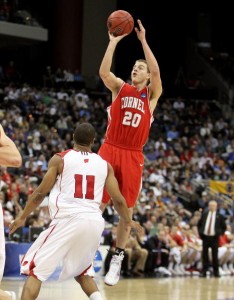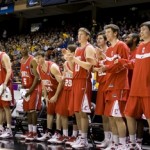Cornell Reaches First-Ever Sweet 16
Back in the day when I was not even a teenager yet, I developed a strong interest for sports. Soccer was my first interest and the first sport that I played competitively. Soon to follow was football, basketball, volleyball, softball, baseball, field hockey, and swimming.
While I did not compete in all these sports, playing just some leisurely, I had developed a fascination for sports to include even croquet, ping pong, badminton and bowling. Growing up in Ithaca, NY, the small city did not have any minor league, major college, amateur, or professional teams. To this day it still does not.
Cornell University and Ithaca College have provided most of the local sports scene along with the high schools generation after generation after generation. Ithaca College has won three Division III national championships in football (last in 1991) and Cornell has won three national titles in lacrosse (last in 1977) while reaching that sport’s final four two of the last three years. Coaches like the late Jim Butterfield of Ithaca College football and Richie Moran, who coached Cornell lacrosse back in the 1970’s, stand tall in the history of the schools.
Ed Marinaro (placed second in the Heismann Trophy voting in 1971 behind quarterback Pat Sullivan of Auburn), Derrick Harmon, and Chad Levitt were all great running backs for Cornell while defensive ends Tom McHale and Seth Payne were great on the other side of the ball. Payne played with the Jacksonville Jaguars of the National Football League. Quarterback Todd Wilkowski and running back Jeff Wittman were on Ithaca’s 1991 national championship team and are two of the programs more successful players.
Yet, while each school has produced great players and had eras of success, nothing has been like what Ithaca has been treated to from the Cornell men’s basketball team the last three years. Three straight outright Ivy League Championships sending them into the NCAA Tournament. Penn and Princeton are the only other Ivy League teams to accomplish that feat since the inception of the Ancient Eight.
You couldn’t envision this back in my early years. I remember going to Cornell basketball games with family and friends at the old Barton Hall (still exists on campus), when the court was set up in the middle of the building and they only used partial bleacher style seating. Cornell would come close but never be able to get over the hump, except once.
The only other time Cornell won the Ivy League Championship prior to this three-year run was the 1987-88 season. They were a 16th seed and lost 90-50 on March 18, 1988 in the NCAA first round to an Arizona team featuring Tom Tolbert, Sean Elliott, and Steve Kerr. However, as this web site states, That was Then, This is Now.

Ryan Wittman is one of the senior leaders for the Big Red.
The Big Red (29-4) went 20 years between Ivy League Championships. In the span of three days, they have made a name for themselves while becoming the first Ivy team since Penn in 1979 to reach the “Sweet 16.” They have done it with size, offensive efficiency, high energy bench play, hot shooting, senior leadership, and strong defensive play.
Cornell, seeded 12th in the East Region and the lowest seed left in the tournament, will meet top seeded Kentucky (34-2) in the East Regional semifinals on Thursday March 25 at 9:57 p.m. inside the Carrier Dome in Syracuse, NY. Syracuse is only about an hour away from the Big Red’s Ithaca, NY campus giving Cornell an edge in proximity and fan support. The other semifinal pits second-seeded West Virginia against 11th-seeded Washington in the evening’s first game.
The Big Red’s combination of 7-foot center Jeff Foote, 6-foot-7 forward Ryan Wittman, and 5-foot-11 guard Louis Dale, all seniors, was lethal in Cornell’s first-ever victories in the NCAA Tournament. In the first round against Temple on March 19, Cornell won 78-65 as Dale (21), Wittman (20) and Foote (16) all scored in double figures. Foote lead the Big Red with seven rebounds while Dale dished out a team high seven assists as Cornell won its’ first ever NCAA Tournament game in program history.
Both teams committed 11 turnovers but Cornell made the Owls pay with an 18-5 scoring edge off of them. A jumper by Wittman with 17:17 left to play in the first half gave Cornell its’ first lead at 6-5 and the Big Red would never trail again. Cornell took care of the ball and passed it effectively to find open shots, converting at a 56.3 percent (27-for-48) clip while holding Temple to 51.9 percent shooting (27-for-52).

Cornell players celebrate at the end of their 87-69 win over Wisconsin
The win over Temple sent the Big Red into the second round where they beat the fourth-seeded Badgers of Wisconsin 87-69 on Sunday March 21. This time, Cornell started quickly by jumping out to an 8-0 lead before Wisconsin scored its’ first point of the game nearly three minutes into the game. Using an active defense, Cornell forced six Badger turnovers in the first half alone and turned them into 11 points.
Wittman’s jumper with eight seconds left to play in the first half gave the Big Red a 43-31 halftime lead and capped a 14-point first-half scoring effort for the senior sharpshooter.
Wisconsin got no closer than nine points in the second half as Cornell maintained its’ offensive efficiency behind some blistering shooting as they shot 61.1 percent for the game (33-for-54) and 53.3 percent (8-for-15) from behind the 3-point line. The Big Red was lead by Dale’s 26 points on 10-for-17 shooting while Wittman added 24 points on 10-for-15 shooting and hit a trio of baskets from behind the three-point line. Cornell held a 29-21 edge in rebounding and got 12 points apiece from Foote and sophomore guard Chris Wroblewski.
While many observers and television analysts from ESPN or CBS say Cornell is a Cinderella, that can be debated. What is known for sure is that Cornell is playing its’ best basketball of the season right now. With that comes momentum that can only help them continue to win. Kentucky would be smart to take notice.
Noteworthy:
*Cornell senior forward/center Marc Coury (6-9, 240) transferred from the University of Kentucky who Cornell will meet on Thursday. Coury started 29 of 31 games for the 2007-08 Kentucky team that reached the NCAA Tournament and finished 18-13. Coury had to sit out the 2008-09 season due to NCAA transfer regulations.

I will be incorporating this to my listing of social book marks.
Bobbing and Ducking a Punch Is Just Bending your knees to get under the punch.A Weave is when u bend your knees but shift your body left to right in a rhythmical motion depending on the fighter.All of this is done with the hands up.Weaving is not the same as ducking.Weaving is more getting low and moving your head in a type of motion.Moving the back backwards is called Leaning back.Leaning back is used when you know how far your opponent can hit you from,you have to know his/her range to lean back.Leaning back is most hard against tall fighters since they have long range.But if you can lean back it is effective,it takes practice though.Leaning back on your back foot while in your stance,as soon as your opponent throws the punch and it doesn’t connect,throw back,usually your power hand followed with a hook.I hope you understand.good luck with boxing.